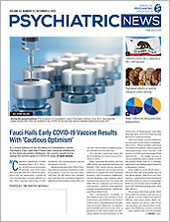Alcohol-related deaths are the third-leading preventable cause of death in the United States, and new data from the Centers for Disease Control and Prevention (CDC) put the death toll in stark relief: From 2006 to 2018, alcohol-induced deaths among adults over 25 increased by 43%.
Now, the COVID-19 pandemic may further worsen the existing crisis. A study published in JAMA Network Open found that, on average, past-month alcohol use increased by 14% among 1,540 study respondents aged 30 to 80 shortly after the start of the pandemic.
The increase is not unexpected, explained Andrew Saxon, M.D., a member of APA’s Council on Addiction Psychiatry. Alcohol use often increases following disasters, and the pandemic certainly represents a huge disruption in people’s lives.
“Problems with alcohol use were on the rise before the pandemic, and it is possible that the pandemic is accelerating that increase,” said Saxon, a professor in the Department of Psychiatry and Behavioral Sciences at the University of Washington and director of the Center of Excellence in Substance Abuse Treatment and Education at the VA Puget Sound Health Care System. “As treatment providers, there are some barriers to overcome, but we must rise to meet the challenge because we may be in this for a few more years.”
Experts are especially concerned about the challenges that people who are recovering from alcohol use disorder (AUD) are facing, as well as those individuals who may develop AUD during the pandemic.
“My primary anxiety has been around not knowing what’s happening yet,” said Jeffrey DeVido, M.D., a member of APA’s Council on Addiction Psychiatry, chief of addiction services for the Marin County Department of Health and Human Services in California, and behavioral health clinical director for Partnership HealthPlan of California. “It’s tough to know what’s happening behind closed doors.”
Existing Problem May Be Worsening
The JAMA Network Open study was based on a survey of 1,540 adults aged 30 to 80 who completed both waves of a Rand Corp. national survey. The baseline survey took place from April 29 to June 9, 2019, and the second wave was conducted from May 28 to June 16, 2020.
The researchers compared the number of days that the participants reported any alcohol use and heavy alcohol use and the average number of drinks consumed over the past 30 days before and during the pandemic. Heavy, or binge drinking was defined as five or more drinks for men and four or more drinks for women over a couple of hours. The researchers used the 15-item Short Inventory of Problems (SIP) scale to assess adverse consequences associated with alcohol use within the past three months, asking participants to respond to statements such as “I have taken foolish risks when I have been drinking.”
On average, past-month alcohol use increased from 5.48 to 6.22 days among all respondents, a 14% increase from 2019 to 2020. Women’s alcohol consumption appeared to be particularly impacted by the pandemic: Past-month alcohol use increased 17% among women, heavy drinking days increased by 41%, and scores on the SIP scale increased by 39%.
“A lot of people expected there would be an increase in alcohol use because people are anxious and depressed, and alcohol use is a common coping mechanism,” said lead author Michael Pollard, Ph.D., a senior sociologist at the Rand Corp. and a professor at the Pardee Rand Graduate School. “But some of the increase is driven by people who weren’t binge drinkers in 2019 becoming binge drinkers. That behavior is particularly bad in the short term, as well as the long term, and to me that is a more concerning finding.”
Pollard said he and his colleagues intend to continue studying this issue. They’ve created two surveys to capture more detailed changes in drinking behavior during the pandemic. One survey is in the field now, and the other will be conducted early next year. “The real question is: Was this just a spike in alcohol use or will this trend continue?” Pollard said.
Either way, the CDC’s data brief exposed another alarming trend in alcohol use. Though the rate of alcohol-induced deaths (including alcoholic liver disease, alcohol-induced acute pancreatitis, accidental and intentional poisoning by and exposure to alcohol, and others) was stable from 2000 to 2006, it increased from 10.7 per 100,000 in 2006 to 15.3 in 2018, representing a 43% increase.
The increase was especially pronounced in rural areas, according to the data brief, with rates 18% higher for males and 23% higher for females compared with urban areas in 2018.
Shrinking Gender Gap in Alcohol Consumption, Death
Pollard’s study and the CDC data point to another disturbing trend around alcohol consumption that researchers have noticed over the last several years: Women are increasingly consuming more alcohol (see
Psychiatric News).
Overall the rate of alcohol-induced deaths was higher for men compared with women, according to the CDC’s data report, but the rate of change was greater for women. The rate for males was 3.6 times the female rate in 2000, but in 2018 the difference fell to 2.6.
Pollard had similar results in his study. He was particularly concerned by the increase in heavy drinking among women that his study identified. One in 15 of the women who participated in the survey and did not engage in binge drinking in 2019 did so in 2020.
“Heavy drinking by women in particular is overlooked in the literature,” Pollard said. “But our findings point out that this is happening, it is a concern, and the literature and researchers should really pay attention to this.”
Treating Alcohol Use as a National Pandemic
It is vital, Saxon said, to educate people about safe drinking limits and the potential risks of consuming too much alcohol. “I don’t think the average person is remotely aware of the safe drinking limits,” he said. “And the data are clear: Once you start exceeding those limits, your morbidity and mortality risk increases.”
He and DeVido pointed to the national response to the opioid epidemic and noted that alcohol use deserves as much attention and funding.
“For the last 10 years or so, most of the nation’s attention has been on the opioid epidemic,” Saxon said. “But equal or more numbers of people have been dying, and at increasing numbers, as a consequence of alcohol use. We need to be paying attention to both.”
DeVido suggested that the two crises of opioid and alcohol use point to a bigger problem. “This is a reminder about the intimate relationship between environment and the development of addiction,” he said. “And I use the word ‘addiction’ intentionally, because it’s also a reminder that while we do have substance-specific treatments, and while it is necessary to identify specific substances that people are using in relation to their addictive behavior, addiction is bigger than just one substance.”
Pollard’s study was supported by a grant from the National Institute on Alcohol Abuse and Alcoholism. ■
“Changes in Adult Alcohol Use and Consequences During the COVID-19 Pandemic in the U.S.” is posted
here.
The CDC data brief is posted
here.

